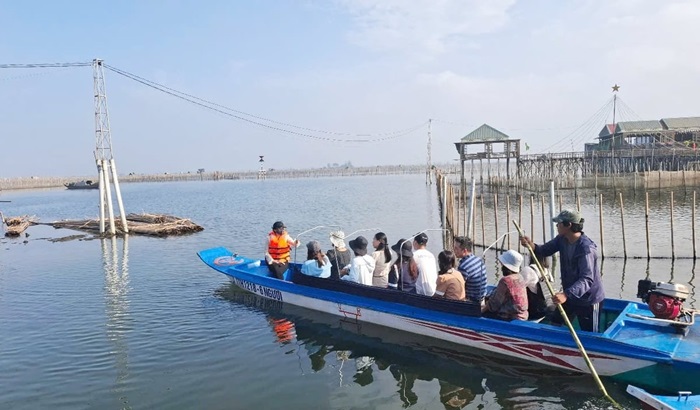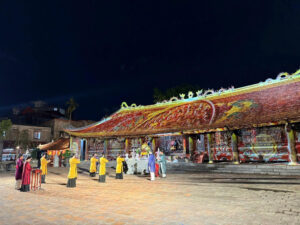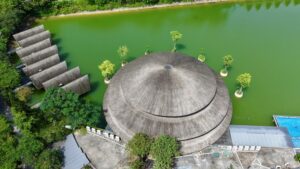Co Thach tourist attraction which belonged to Binh Thanh commune (Tuy Phong district), has attracted a great number of tourists in some recent years. This is a complex of tourist attractions including pagoda, beach, rocky shore, sand dunes, fishing village, ... combining together to create a continually image in motion. Perhaps this is the reason why it’s like a new emotion every time we come.
The sea is unchanged and its wave laps the shore playfully. Co Thach pagoda remains quiet and mixes the sound of the temple bell with the sound of the wave lapping. So is the village which is always hurried and bustling with its batches of fishes. All have not changed, but they give tourists the feeling of continuous motion in that natural picture and lively people.
When setting foot on Co Thach, the first destination is Hang pagoda whose pen-name is To Dinh Co Thach, located in a cave on the coastal hill. However, Co Thach pagoda does not have only a sanctuary like other pagodas but it also has tens of architectural works stretching along the beach such as: shrine of Buddha, ancestral temple and tower, and the statues of the Lord of Buddha Nirvana, Mitreya, and Bodhisattva Avalokiteshvara on the hill. Surrounding the pagoda are big rocks with different shapes and many caves which is very intriguing and mysterious, penetrate deeply into the mountain. The pagoda still preserves many antiques like Dai Hong Chung (big bell), drum and numerous precious Han-Nom heritages, parallel sentences, horizontal lacquered boards, literary materials, etc.
For that very reason, Co Thach pagoda was ranked as a national scenic relic in 1993. Every year, there are tens of thousands of domestic and foreign tourists coming here to do sightseeing and making a pilgrimage. Most of them are Buddhist followers. Besides coming here to seek for a peace of soul, they also visit this waters to contemplate the unique landscape with full of sun and wind.
After sightseeing Co Thach pagoda, visitors can immediately see a sparkling multicolored rocky expanse. This rocky expanse located along the over 1-kilometer-long coast with innumerable colorful and multi-dimensional stones (most stones are at medium-sized and equal in size to man’s fist). Especially, this whole large area retains its charming and wild feature. The common people called this place “seven-color rocky expanse” because those small rocks emerged from the seabed toward the beach due to the influence of the nature and terrain. Visitors coming here often pick some beautiful stones up as souvenirs. It’s extraordinary that the number of stones/small rocks here have never reduced despite tens of thousands of visitors coming and bringing some of them away.
If visitors have good condition, they can take local motorbike taxies to the sand hill and the nearby Ong Nam Hai temple (whale-worship temple) in Tuy Phong district. The temple is not so big as others, but it has the ancient date and keeps a lot of large and small whale’s skeleton. The temple is located in front of the mild and peaceful seashore, and behind it is a high and cool sand hill where we can view the panorama of the fishing village surrounding the temple whose architecture bears the oriental stamp with plentiful patterns of dragon, flowers and foliage, was built from the Minh Mang dynasty. The inner part of the temple was decorated solemnly, gorgeously, and somewhat mysteriously.
According to some documents, legend has it that hundreds years ago, a dead whale (Ong Nam Hai) weighing tens of tons drifted to the seashore. Local people buried “Ong Nam Hai” and established a temple for worship by the sea. Moreover, other smaller whales’ skeletons were also discovered later at this place. So far, local people have buried, preserved and worshipped more than 100 remains of whales.














